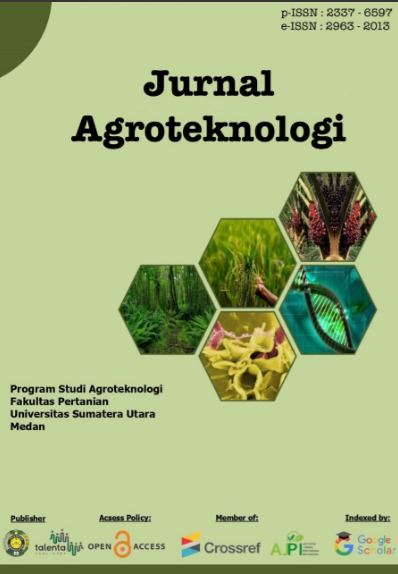Kajian Status Hara Tanah di Bawah Tegakan Sistem Agroforestri Berbasis Karet di Kecamatan Bahorok, Kabupaten Langkat
DOI:
https://doi.org/10.32734/ja.v11i3.20515Keywords:
Rubber agroforestry, soil nutrient status, soil depthsAbstract
This research aims to examine the soil nutrient status in rubber agroforestry systems in Bahorok subdistrict, Langkat Regency affected by species combinations (rubber monoculture, rubber-Durio zibethitus, rubber-Elaeis guineensis, rubber-Garcinia atroviridis, rubber-Aquilaria malaccensis, rubber-Arenga pinnata agroforestry) and soil depths (0-20 cm, 30-60 cm). The survey method was based on the concept of Ex-post facto and designed by Factorial Randomized Block Design. The observed parameters were N-total, P-available, and exchangeable cations of K, Ca, Mg, and Na. Soil samples were taken by purposive sampling technique, and the data analysis was done by ANOVA followed by Duncan’s Multiple Range Test at 5%. This research was done on soil with the same texture class so that variations in the soil nutrient concentrations were not affected by the different soil characteristics but by the effect of different agroforestry types. The results demonstrated that the best rubber agroforestry system was rubber-Garcinia atroviridis agroforestry where the concentrations of N, K, Ca, and Mg were the highest, except the P-available. However, the rubber agroforestry systems were not significant to Na. The best soil depth on rubber agroforestry systems was 0-20 cm, which showed the highest concentrations of N and K compared to 30-60 cm, but the soil depths were not significant in P, Ca, Mg, and Na concentrations. The interactions between species combinations and soil depths in rubber agroforestry systems were not significant in all observed parameters.
Downloads
Downloads
Published
Issue
Section
License
Copyright (c) 2025 JURNAL AGROTEKNOLOGI

This work is licensed under a Creative Commons Attribution-ShareAlike 4.0 International License.
The Authors submitting a manuscript do so on the understanding that if accepted for publication, copyright of the article shall be assigned to Jurnal Online Agroekoteknologi as well as TALENTA Publisher Universitas Sumatera Utara as the publisher of the journal.
Copyright encompasses exclusive rights to reproduce and deliver the article in all forms and media. The reproduction of any part of this journal, its storage in databases and its transmission by any form or media, will be allowed only with written permission from Jurnal Online Agroekoteknologi.
The Copyright Transfer Form can be downloaded here.
The copyright form should be signed originally and sent to the Editorial Office in the form of original mail or scanned document.











